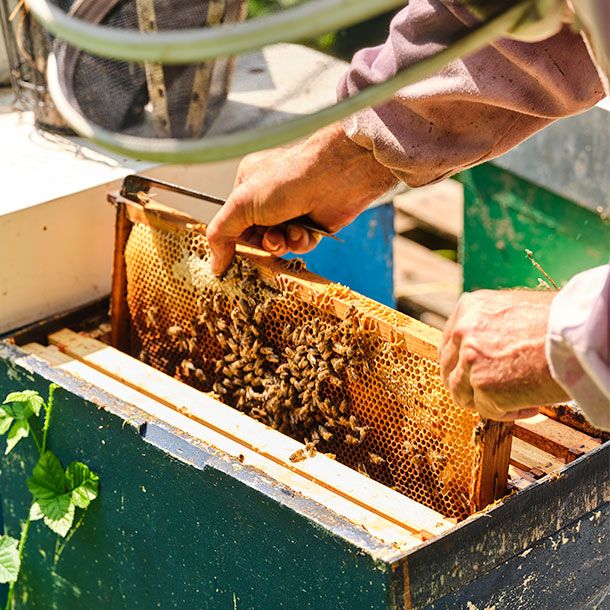
The bee blog
Pollinators, such as bees, are vital in producing our food and wild bees like bumblebees are in decline. We are working to protect wild pollinators as well as well as introducing 30 million honeybees to our M&S Select Farms to make some very special honey. Scroll down to follow the story of these very busy bees and learn how you can support bumblebees.
Show me the honey!
In 2021, we put over 600 beehives, which are home to 30 million bees, on 25 M&S Select Farms. These busy bees are helping us produce our exclusive single-estate Collection Select Farms honey. Because we are harvesting from different farms, where the bees have foraged on everything from cherry trees to courgettes, the honey comes in lots of different colours and unique flavours.
Honeybees are important pollinators. By introducing honeybees to M&S Select Farms, we’re supporting local honey production and our Select Farms to pollinate their crops. Our work with honeybees is only part of the story, click below to see how we are supporting wild pollinators.
How is the honey made?
Each hive has ‘scout’ bees that find the best sources of nectar and pollen from which to forage. Because the farms are so diverse, these could range from dandelions to apple and pear orchards, bluebell woods, and sycamore and hawthorn trees, cherries and gooseberries, blackcurrants and beans – all of which will give each honey its own distinct flavour profile. The bees gather their nectar and bring it back to the hives and start filling honeycombs. In the evening, they use their wings to fan the nectar, evaporating moisture and concentrating the liquid to make honey.
Heavenly honey recipes
Put our Collection Select Farms honey to delicious use by trying out chef Chris Baber’s flavour-packed recipe ideas. First up is his honey halloumi with piri piri sweet potato and quinoa salad, which is the perfect light supper for sunny evenings. And for pud? You need to try Chris’s mini pavlovas topped with blueberries, raspberries, cream and honey, with a nutty crumble.
Pick up everything you need to make these tasty recipes, including our Collection Select Farms honey, in store now.
AMAZING HONEYBEE FACTS

Clear communicators
Bees communicate with each other so that the colony can find the best source of nectar or the best nest site for their swarm
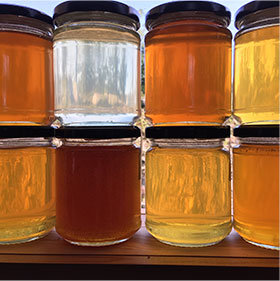
Quality control
The bees know when their honey is ready to be sealed with beeswax – they’re like food technologists in the hives, checking on the quality of the honey
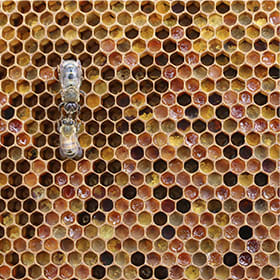
Energy efficient
Bees make honeycomb in a way that’s mathematically perfect to hold the most amount of honey using the least amount of wax

A hive of activity
Bees have a series of different job roles in their lifetimes, from nurse bees who look after the young bees, to scout bees and foragers
Bee the Change
Honeybees and bumblebees may seem like the same thing, yet honeybees are in fact domesticated across the region and usually managed by an expert beekeeper, whereas bumblebees are wild! Expert says: "You can also usually tell them apart because bumblebees are big, round and furry, but honeybees are smaller, slimmer and much less hairy."
Wild bees, such as bumblebees and solitary bees, work hard pollinating our crops and wildflowers for free, so more wildflowers can grow, and we can enjoy delicious foods like tomatoes and blueberries. However, our native bumblebees are struggling because they do not have enough flowers to feed on. Fortunately, there are lots of quick, simple things you can do to make your local area more bumblebee-friendly – plus they are easy and fun!
HOW YOU CAN MAKE A DIFFERENCE
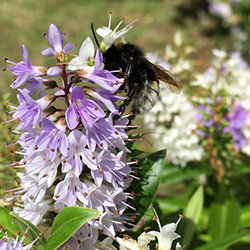
Make your space bumblebee friendly
Add one bumblebee-friendly plant to your outdoor space – whether you have flowerpots, a window box, hanging baskets or a traditional flower bed. Your local garden centre will be able to help you pick!

Keep things natural
Make space for bumblebee nests by leaving ‘untidy’ areas in your garden: let patches of grass grow longer and wild, or start a compost heap.

Spread the word
To inspire even more people to help bumblebees, or have fun designing your own!

Become a bee expert
People of all ages can have fun spotting bumblebees this summer and learning about the different species
BRILLIANT BUMBLEBEE FACTS

Colourful tails
There are 24 species of wild bumblebee across the region, and they fall into three main groups based on the colour of their tails: red, white, or ginger/yellow. Looking at the tail colour is the simplest way to start identifying a bumblebee.

Sleepy bumblebee queens
Only bumblebee queens survive the winter by hibernating, so if you find a lone bumblebee sleeping in your garden in late winter or early spring, try not to disturb them as they’ll need to remain covered under the soil or leaves until it’s warm enough for them to survive out in the open.
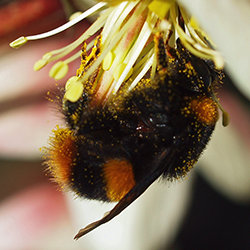
Super bees!
Bumblebees have a ‘superpower’ called buzz pollination, where they vibrate their bodies to make some flowers release their pollen in a tiny yellow explosion! Blueberries and tomatoes are just two of the many plants that need this type of pollination.

Bumblebee dream teams
Bumblebees work in small colonies of up to 400, and cooperate with others in the colony – for example, working together to fan cooler air into their nest and providing food too.
How is M&S supporting wild pollinators?
Farmers play an important role in protecting pollinators and you can read about some of our brilliant growers and what they are doing to protect pollinators here. over the next few years we are delivering a programme for all M&S growers in the Ireland, aiming to enhance nature-friendly outcomes that will see all growers monitoring pollinators, managing a minimum of 5% habitat area on their farms for wildlife and demonstrating a reduced reliance on pesticides. We are also working with expert partners and growers to test and learn innovative pollinator-friendly farming methods, like planting wildflowers inside strawberry polytunnels.
We are passionate about continuing to support and grow beekeeping. To do that we understand it is important to produce honey responsibly and to avoid any negative impact on wild pollinators.we are working on a Responsible Honeybee Farming Standard, which we believe will be the first of its kind.
As part of a broader family campaign, we will be encouraging parents and their children to look out for special bee signage in store, highlighting which of our delicious products have been helped either by wild bees such as bumblebees or honeybees.

